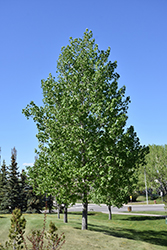It's all about ...
plants

Height: 50 feet
Spread: 25 feet
Sunlight:
![]()
Hardiness Zone: 2a
Other Names: Hybrid Poplar
Description:
A tall, narrowly upright and fast-growing tree that's tolerant of the worst growing conditions; good disease resistance; this hybrid produces no fuzz; has an aggressive root system, so don't plant near the house; makes a fine windbreak or quick shade tree
Ornamental Features
Brooks Poplar is primarily valued in the landscape for its distinctively pyramidal habit of growth. It has rich green deciduous foliage. The large heart-shaped leaves turn yellow in fall.
Landscape Attributes
Brooks Poplar is a deciduous tree with a distinctive and refined pyramidal form. Its relatively coarse texture can be used to stand it apart from other landscape plants with finer foliage.
This tree will require occasional maintenance and upkeep, and is best pruned in late winter once the threat of extreme cold has passed. Gardeners should be aware of the following characteristic(s) that may warrant special consideration;
- Invasive
- Disease
Brooks Poplar is recommended for the following landscape applications;
- Shade
- Vertical Accent
- Hedges/Screening
- Windbreaks and Shelterbelts
Planting & Growing
Brooks Poplar will grow to be about 50 feet tall at maturity, with a spread of 25 feet. It has a high canopy with a typical clearance of 7 feet from the ground, and should not be planted underneath power lines. As it matures, the lower branches of this tree can be strategically removed to create a high enough canopy to support unobstructed human traffic underneath. It grows at a fast rate, and under ideal conditions can be expected to live for 60 years or more.
This tree should only be grown in full sunlight. It is an amazingly adaptable plant, tolerating both dry conditions and even some standing water. It is considered to be drought-tolerant, and thus makes an ideal choice for xeriscaping or the moisture-conserving landscape. It is not particular as to soil type or pH, and is able to handle environmental salt. It is highly tolerant of urban pollution and will even thrive in inner city environments. This particular variety is an interspecific hybrid.
